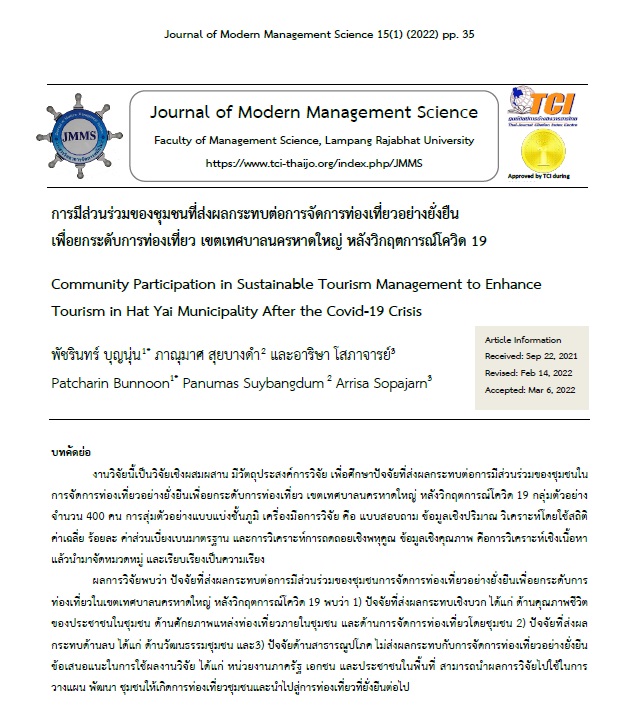Community Participation in Sustainable Tourism Management to Enhance Tourism in Hat Yai Municipality After the Covid-19 Crisis
Main Article Content
Abstract
The research aims to study the factors affecting community participation in sustainable tourism management to enhance tourism in Hat Yai municipality after the Covid-19 crisis. The distribution of questionnaires was conducted to generate for 400 stratified random sampling participants. Statistical analysis was designed to carry out as quantitative data which is composed of mean, standard deviation, and multiple linear regression. Qualitative data was employed through the use of content analysis.
The results of studying factors affecting community participation in sustainable tourism management to enhance tourism in Hat Yai municipality after the Covid-19 crisis showed the following findings: 1) Positive influence of factors; community-based tourism management; quality’s life of people; community-based tourism potential Negative influence of factor; community culture 3) No influence of factor; public utilities. Suggestions for using research results include government agencies, the private sector, and people in the area. The research results can be use in community planning and development to create community tourism and lead to sustainable tourism.
Article Details

This work is licensed under a Creative Commons Attribution-NonCommercial-NoDerivatives 4.0 International License.
The article must be considered and accepted for publication by the editorial board of the Faculty of Management Science, Lampang Rajabhat University. The articles have been reviewed by a peer (peer review) and the author must update according to the suggestion if available before publication. Articles that are not considered the editorial team will inform the results of the consideration but will not send the original to the author.
JMMS is the Faculty of Management Science journal, Lampang Rajabhat University. Jmms published both print and online editions. We allow the use of articles for academic use under the scope of copyright law.
References
ขัตติยา กลัญทกะปกรณ์, สุธีรา สิทธิกุล และวินิตรา ลีละพัฒนา. (2563). การพัฒนาศักยภาพการท่องเที่ยวเชิงเกษตรชุมชนเกษตรตำบลห้วยทราย อำเภอแม่ริม จังหวัดเชียงใหม่. วารสารวิทยาการจัดการสมัยใหม่, 13(2), 29-44.
จิรัชยา เจียวก๊ก,สันติชัย แย้มใหม่ และพัตรธีรา จินตานนท์. (2558). คุณภาพชีวิตของประชาชนเทศบาลเมืองคอหงส์ อำเภอหาดใหญ่ จังหวัดสงขลา. ใน การประชุมหาดใหญ่วิชาการระดับชาติ ครั้งที่ 6 (น.435-450) สงขลา: มหาวิทยาลัยหาดใหญ่.
ฉัตรทิพย์ นาถสุภา. (2540). ประวัติศาสตร์ วัฒนธรรมชุมชนและชนชาติไท. (พิมพ์ครั้งที่ 1). กรุงเทพฯ: สํานักพิมพ์แห่งจุฬาลงกรณ์มหาวิทยาลัย.
ชนิษฎา ชูสุข, จิตราวดี ฐิตินันทกร และจุฑารัตน์ รัตนพิทักษ์ชน. (2556). เครือข่ายเมืองในเอเชียเพื่อรับมือกับการเปลี่ยนแปลงสภาพภูมิอากาศด้านการรับมือของเมืองกับการเปลี่ยนแปลงสภาพภูมิอากาศ. (รายงานผลการวิจัย). สงขลา: มหาวิทยาลัยสงขลานครินทร์.
ชลลดา แสงมณี ศิริสาธิตกิจ และธีรศักดิ์ อุ่นอารมย์เลิศ. (2557). การพัฒนารูปแบบการท่องเที่ยวตลาดน้ำภาคใต้เพื่อการพัฒนาที่ยั่งยืน. วารสารศิลปากรศึกษาศาสตร์วิจัย, 6(1), 66-79.
ถนัด คอมันตร์. (2561). แผนยุทธศาสตร์และแผนปฏิบัติการ พัฒนาศักยภาพการท่องเที่ยวของจังหวัดสงขลา เพื่อเพิ่มนักท่องเที่ยวจากอินโดนีเซียและประเทศสมาชิกอาเซียนใต้ (รายงานผลการวิจัย). สงขลา: มหาวิทยาลัยสงขลานครินทร์.
เทศบาลนครสงขลา. (2564). ประชากร เศรษฐกิจ สังคม ประเพณี ศิลปะ และวัฒนธรรม. สืบค้นเมื่อ 1 กันยายน 2564, จาก https://sites.google.com/site/ssm56021285/general/intro-to-community/population-economy-society-tradition-art-culture
เทศบาลนครหาดใหญ่. (2558). สมัชชาประชาชนนครหาดใหญ่ ด้านทิศทางการพัฒนาเมือง. สงขลา: เทศบาลนครหาดใหญ่.
เทศบาลนครหาดใหญ่. (2561). โครงการประเมินความสำเร็จตามยุทธศาสตร์การพัฒนาเทศบาลนครหาดใหญ่ ประจำปี พ.ศ.2561. รายงานวิจัย. สงขลา: เทศบาลนครหาดใหญ่.
เทศบาลนครหาดใหญ่. (2562). แผนพัฒนาท้องถิ่น (2561 - 2564) เทศบาลนครหาดใหญ่. สงขลา: เทศบาลนครหาดใหญ่.
ธัญรดา ดวงแก้ว และนัทนิชา หาสุนทรี. (2563). การมีส่วนร่วมของประชาชนตามหลักการท่องเที่ยวอย่างยั่งยืนของหมู่บ้านท่องเที่ยวเชิงอนุรักษ์บ้านไทรน้อย จังหวัดพระนครศรีอยุธยา. วารสารมนุษยศาสตร์และสังคมศาสตร์ มหาวิทยาลัยราชพฤกษ์, 6(1), 41-52.
ธุรกิจท่องเที่ยว. (2564, 4 เมษายน). ท่องเที่ยวโค้งแรกปี’64 สาหัสทั่วหล้ารายได้เข้าไม่เกิน 10%. ประชาชาติธุรกิจออนไลน์. สืบค้นเมื่อ 20 สิงหาคม 2564 จาก https://www.prachachat.net/tourism/news-641700
ประคอง สุคนธจิตต์, สุนันทา งามเดโช และ ดาวพันธ์ เฉลยพงษ์. (2561). การมีส่วนร่วมของประชาชนเกี่ยวกับการบริหารจัดการเศรษฐกิจชุมชน. วารสารร่มพฤกษ์ มหาวิทยาลัยเกริก, 36(1), 181-200.
พัชรินทร์ บุญนุ่น, ลัดดา ทองตั้ง วันดี นวนสร้อย. (2563). การศึกษาพฤติกรรมของนักท่องเที่ยวชาวไทยที่มีต่อการสร้างมูลค่าเพิ่มของชุมชนย่านฉื่อฉาง อำเภอหาดใหญ่ จังหวัดสงขลา กรณีศึกษา: ช่วงเทศกาลกินเจ. วารสารปัญญาภิวัฒน์, 12(2), 135-148.
ไพศาล วรคำ. (2556). การวิจัยทางการศึกษา. (พิมพ์ครั้งที่ 6). มหาสารคาม: ตักสิลาการพิมพ์.
ราชกิจจานุเบกษา. (2561). ยุทธศาสตร์ชาติ. เล่ม 135 หมวด 82 ก. ราชกิจจานุเบกษา.
วิภา ศรีระทุ. (2551). ศักยภาพแหล่งทองเที่ยวเชิงนิเวศ ในอำเภอเขาคอ จังหวัดเพชรบูรณ. (สารนิพนธ์ปริญญาวิทยาศาสตรบัณฑิต สาขาวิชาการวางแผนและการจัดการการท่องเที่ยวเพื่ออนุรักษ์สิ่งแวดล้อม. วิทยาศาสตรมหาบัณฑิต). มหาวิทยาลัยศรีนครินทรวิโรฒ. สืบค้นเมื่อ 20 สิงหาคม 2564 จาก http://thesis.swu.ac.th/ swuthesis/Eco_Pla_Man/Vipa_S.pdf
ศูนย์วิจัยกสิกรไทย. (2564). โควิด-19 ระลอกใหม่ ป่วนการท่องเที่ยวระหว่างประเทศทั่วโลกและไทยในช่วงที่เหลือของปี 2564 (กระแสทรรศน์ ฉบับที่ 3255) สืบค้นเมื่อ 26 สิงหาคม 2564 จาก https://kasikornresearch.com/th/analysis/k-econ/business/Pages/Covid-Travel-z3255.aspx
เศรษฐกิจภูมิภาค. (2563, 29 มิถุนายน). “หาดใหญ่” นิ่งสนิท “มาเลเซีย” ปิดเมืองยาวถึง 31 ส.ค. ประชาชาติธุรกิจออนไลน์. สืบค้นเมื่อ 20 สิงหาคม 2564 จาก https://www.prachachat.net/local-economy/news-483497
สุรวุฒิ ปัดไธสง. (2545). วัฒนธรรมชุมชน: เงื่อนไขความเข้มแข็งชุมชน/หมู่บ้าน. วารสารพฤติกรรมศาสตร์. 8(1), 11-20.
Arnstein, S. R. (1969). A ladder of citizen participation. Journal of the American Institute of Planners. 35(4), 216-224.
Cohen, J. M., & Uphoff, N. T. (1980). Participation's place in rural development: Seeking clarity through specificity. World Development. 8(3), 213-235.
Cronbach, L. J. (1970). Essentials of Psychological Testing. New York: Harper & Row.
Eber, L. (1993). Brundtland report. London Pergamen press ltd.
Ferrans, C.E. & Power, M.J. (1985). Quality of Life Index : Development and Psychometric Properties. Advanced in Nursing Science. 8(1), 15–24.
Giampiccoli, A., & Kalis, J. H. (2012). Tourism, Food, and Culture: Community-based Tourism, Local Food, and Community Development in Mpondoland. Culture, Agriculture, Food and Environment. 34(2), 101 – 123.
Likert, R. (1967). The Method of Constructing and Attitude Scale. In Reading in Fishbein, M (Eds.), Attitude Theory and Measurement. New York: Wiley.
Mearns, K. (2003). Community-based tourism: The key to empowering the Sankuyo community in Botswana. Africa Insight, 33(1&2), 29-32.
Padilla, G.V., & Grant, M.M. (1985). Quality of life as a cancer nursing outcome variable. Advances in Nursing Science, 8(1), 45 – 60.
Singh, L. K. (2008). Ecology, Environment and Tourism. Delhi: ISHA Books
Swarbrooke, J . (1998).Sustainable Tourism Management. Wallingford, UK: CAB International.
Telfer, D. J. (2009) “Development studies and tourism”. In Jamal, T.and Robison, M. (eds.), The SAGE handbook of tourism studies. London: SAGE Publications.
William, E. (1976). Participation Management: Concepts, Theory and Implementation. Atlanta G.: Georgia State University.
Zhan, L. (1992). Quality of Life : Conceptual and measurement issues. Journal of Advanced Nursing 17(7), 795 – 800.


